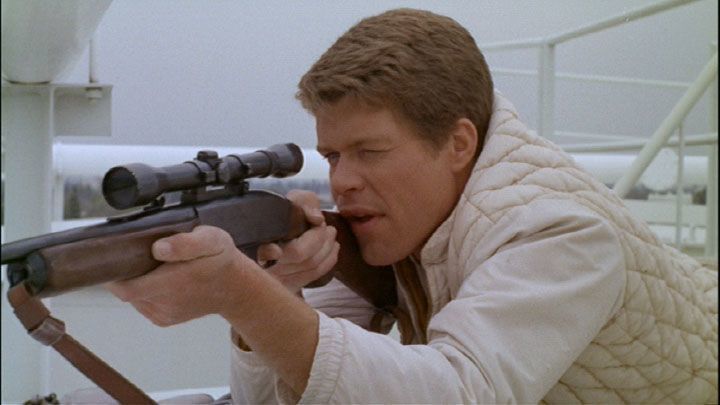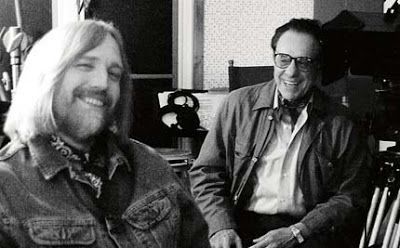
Peter Bogdanovich
The sobering news over the weekend reminded me of “Targets” and ‘Runnin’ Down a Dream,’ both films directed by Peter Bogdanovich. He wrote and directed “Targets” about 50 years ago, and directed the sprawling 4-hour Tom Petty documentary in 2007. Both of these films are distinctly American, and relevant to the mass shooting in Las Vegas, and Petty’s death.
Both films are vastly different in terms of subject matter but similar for quintessentially ascribing to the tenets of Americana: one depicts the journey of a creative artist through the rock and roll music landscape, and the other, reveals the crystallization of an American nightmare, and serves as a harbinger of things to come with the country’s gun-crazed sensibilities.
In “Targets,” one plotline depicts an all-American young man who suddenly goes on a killing spree. Bobby Thompson, as played by Tim O’Kelly, is a quiet, young insurance agent and Vietnam War veteran who lives in a suburban Los Angeles neighborhood with his wife and parents. Thompson, inexplicably, kills his wife, mother, and a delivery boy at his home while his father is at work. Thompson then goes on a rampant killing spree, where he shoots at passing drivers from atop an oil storage tank that sits alongside a heavily traveled freeway.
“We took the sniper from Austin, Texas, the kid who shot 35 people in 1966 - we took his story and connected it with a story of a horror-movie star who’s quitting because he feels his kind of horror is outdated, and he’s become like a dinosaur,” Bogdanovich said in an interview with Dissolve. “Well, the story’s impossible to tell without showing the gun culture. Of course, the gun culture was very much on my mind. It was terrible then, it’s terrible now... I’ve experienced personal tragedy as a result of the gun culture in this country, which is disgraceful, frankly,” he added.
This is the ultimate American horror story, as the characters and actions of the killer are patterned after the University of Texas sniper, Charles Whitman.
On August 1, 1966, Whitman climbed to the top of the Texas Tower at the University of Texas campus where he fired his rifle, shooting 47 people, which killed 16. “The Texas Tower” incident was cited as the beginning of the active shooter era and cited as one of the reasons police departments began to develop special operations teams in the United States.
America’s spate of gun violence has only increased in recent decades, with mass shootings at universities, high schools, movie theaters, places of worship, and concert venues. Clearly, Bogdanovich was onto something about human behavior. This type of insanity in American life would only worsen in the decades to follow.
“The editor of Esquire said to me: Why don’t you make a movie on Charles Whitman?” Bogdanovich said in another interview. “It was shot in many little pieces… We shot at the freeway, on the freeway, and stayed there. I don’t know how we got away with it. The shooting was all done in two days, and it was done silently.“
Reviews of the film were good at the time, though it did not gain a wide distribution despite being released by Paramount Pictures.
“Targets…’ is an interesting one,” Roger Ebert wrote in 1968. “Tim O’Kelly plays a clean-cut seemingly normal kid who likes guns. In the most subtle way, Bogdanovich suggests that the youth’s obsession hides deep feelings of insecurity; beneath the all-American image are few human resources. The suggestion is that the sniper can’t tell illusion from reality. His victims were perhaps no more real than movie people, or tin cans used as targets.”
“[Targets] is a fascinating commentary on American mythology, exploring the relationship between the inner world of the imagination and the outer world of violence and paranoia, both of which were relevant to contemporary American traumas,” raved critic Geoff Andrew.

A scene from “Targets,” released in 1968.
Nearly 40 years later, Bogdanovich directed the exhaustive 4-hour music documentary on the life and times of songwriter and classic rock icon Tom Petty. The film, ‘Runnin’ Down a Dream,’ released in 2007, garnered the director a Grammy for Best Music Film.
Bogdanovich admittedly did not know much about Petty’s music before he shot the film, but soon grew enraptured by the Gainesville rock star’s ability to connect to his fans, and the great depths of his songwriting prowess.
He attended about 10 to 15 shows during Petty’s nationwide tour for the film.
“I‘m challenged by things I don’t know how to do. It was that I didn’t know much about him or the medium that interested me,” Bogdanovich told Reuters. “It’s the discovery of something that makes it fresh for me.”
Bogdanovich later told an audience at the New York Film Festival that he felt akin to Petty’s humanistic mission as a music artist. “I think Tom’s politics is in his work. He’s a humanist. What he feels about the world comes through in his work, and he’s not a didactic record producer or songwriter… It’s on a human level… it’s the humanity that works for Tom. It works for me.”

Tom Petty and Peter Bogdanovich.
Bogdanovich is certainly working on a human level, too, in “Targets” and “Runnin’ Down a Dream’ but in diametrically opposed ways. One film serves as a cautionary tale and the other presents an all-American musician who has realized his artistic dreams.
Through Bogdanovich’s perceptive direction, each film interweaves particular fabrics within the American landscape: one that raises its glass to a consummate performer who gave millions happiness and inspiration, while the other warns of how a society marred by paranoia and fear can make an American mind descend to madness.
